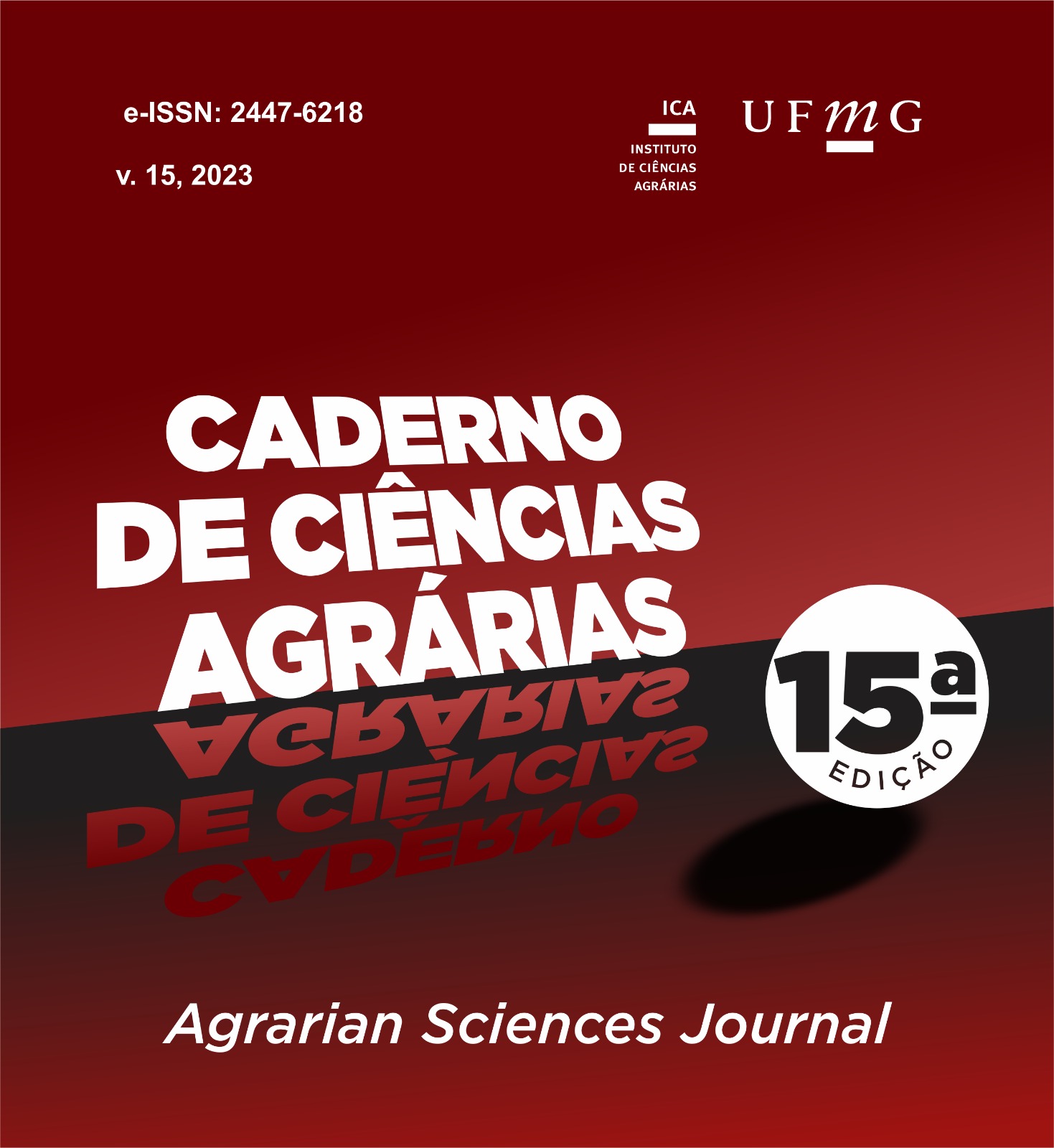Uso de modelos não lineares para avaliar a curva de crescimento de ovinos
DOI:
https://doi.org/10.35699/2447-6218.2023.45002Palavras-chave:
Avaliadores de qualidade, Modelo logístico, Peso adulto, Quadrado médio do erroResumo
Objetivou-se utilizar modelos de regressão não linear para avaliar a curva de crescimento de cordeiros. Para isso, foram utilizados dados referentes ao peso e idade de 70 cordeiros mestiços Dorper x Santa Inês nascidos entre os anos de 2016 a 2019. O sistema de produção era intensivo e semi-confinado. Os dados dos animais foram ajustados por meio dos modelos não lineares Brody, Von Bertalanffy, logístico e Gompertz. Para comparar o ajuste dos modelos foram utilizados os avaliadores de qualidade do ajuste: quadrado médio do erro (QME), coeficiente de determinação (R2) e porcentagem de convergência (%conv). As curvas de crescimento foram feitas por ajustes individuais. Todas as análises foram realizadas utilizando o software RStudio, versão R 4.1.2. O modelo Logístico foi o que melhor estimou o parâmetro a (peso adulto) com 48,09 kg, enquanto os demais superestimaram a realidade biológica do parâmetro. Da mesma forma, apresentou o maior valor referente ao parâmetro k (taxa de maturidade) com 0,0219. Todos os modelos obtiveram coeficiente de determinação (R²) superior a 96%. O modelo de Von Bertalanffy apresentou o menor QME (1,61), seguido de Gompetz (2,27), Logístico (2,76) e Brody (3,36). O modelo Logístico obteve a maior percentagem de convergência de dados (87,14%), seguido de Gompertz (71,43%), Von Bertalanffy (35,71%) e Brody (10%). Portanto, o modelo logístico apresentou o melhor ajuste perante os demais com R² adequado, baixo QME, alta porcentagem de convergência e valor assintótico adequado, não tendendo a superestimar o peso adulto.
Referências
Farhadian, M.; Rafat, S. A.; David, I. 2022. Determination of the best non-linear funcion and genetic parameters on early growth in Romane lambs. Journal of Science and Technologies, 10:1-9. doi: https://doi.org/10.22103/JLST.2022.16350.1327
Farrell, L. J.; Kenyon, P. R.; Tozer, P. R.; Ramilan, T.; Cranston, L. M. 2020. Quantifying sheep enterprise profitability with varying flock replacement rates, lambing rates, and breeding strategies in New Zealand. Agricultural Systems, 184:1-11. doi: https://doi.org/10.1016/j.agsy.2020.102888 DOI: https://doi.org/10.1016/j.agsy.2020.102888
Hossein-Zedh, N. G. 2015. Modeling the growth curve of Iranian Shall sheep using non-linear growth models. Small Ruminant Research, 130:60-66. doi: https://doi.org/10.1016/j.smallrumres.2015.07.014 DOI: https://doi.org/10.1016/j.smallrumres.2015.07.014
Kucukonder, H.; Demirarelan, P. C.; Alkan, S.; Ozgur, B. B. 2020. Curve fitting with nonlinear regression and grey prediction model of broiler growth in chickens. Pakistan Journal of Zoology, 52:347-357. doi: https://doi.org/10.17582/journal.pjz/2020.52.1.347.354 DOI: https://doi.org/10.17582/journal.pjz/2020.52.1.347.354
National Research Council - NRC. 2007. Nutrient requirements of small ruminants. Washington, D. C.: National Academy Press., 362 p.
R Core Team. 2022. R: A language and environment for statistical computing. Disponível em: https://www.R-project.org/. Acesso em: 12 de abril de 2023.
Raineri, C,; Nunes, B. C. P.; Gameiro, A. H. 2015. Technological characterization of sheep production systems in Brazil. Animal Science jornal, 86:476-485. Doi: https://doi.org/10.1111/asj.12313 DOI: https://doi.org/10.1111/asj.12313
Selvaggi, M.; Laudadio, V.; D’Alessandro, A. G.; Dario, C.; Tufarelli, V. 2017. Comparison on accuracy on diferente nonlinear models in predicting growth of Podolica bulls. Journal of animal sciences, 66:1126-1133. doi: https://doi.org/10.1111/asj.12726 DOI: https://doi.org/10.1111/asj.12726
Sharif, N.; Ali, A.; Mohsin, I.; Ahmad, N. 2021. Evaluation of nonlinear models to define growth curve in Lohi sheep. Small Ruminant Research, 205:1-9. doi: https://doi.org/10.1016/j.smallrumres.2021.106564 DOI: https://doi.org/10.1016/j.smallrumres.2021.106564
Van der Merwe, D. A.; Brand, T.S.; Hoffman, L.C. 2019. Application of growth models to diferente sheep breed types in South Africa. Small Ruminant Research, 178:70-78. doi: https://doi.org/10.1016/j.smallrumres.2019.08.002 DOI: https://doi.org/10.1016/j.smallrumres.2019.08.002
Varanis, L. F; Silva, N. A. M.; Teixeira, A. M. 2016. Seleção de modelos não lineares para estimação da curva de lactação de vacas mestiças pelo método de análise de agrupamento. Caderno de Ciências Agrárias, 8:28-37. doi:
Weber, S. H.; Santos, S. K.; Heizen, B. C.; Viana, N. P.; Sotomaior, C. S. 2021. Comparison of nonlinear mathematical models for lamb growth analysis. Tropical Animal Health and Production, 53:1-9. doi: https://doi.org/10.1007/s11250-021-02597-3 DOI: https://doi.org/10.1007/s11250-021-02597-3
Publicado
Edição
Seção
Licença
Copyright (c) 2023 Caderno de Ciências Agrárias

Este trabalho está licenciado sob uma licença Creative Commons Attribution 4.0 International License.
Autores que publicam nesta revista concordam com os seguintes termos:
Os Direitos Autorais para artigos publicados nesta revista são de direito do autor. Em virtude da aparecerem nesta revista de acesso público, os artigos são de uso gratuito, com atribuições próprias, em aplicações educacionais e não-comerciais.
A revista se reserva o direito de efetuar, nos originais, alterações de ordem normativa, ortográfica e gramatical, com vistas a manter o padrão culto da língua e a credibilidade do veículo. Respeitará, no entanto, o estilo de escrever dos autores.
Alterações, correções ou sugestões de ordem conceitual serão encaminhadas aos autores, quando necessário. Nesses casos, os artigos, depois de adequados, deverão ser submetidos a nova apreciação.
As opiniões emitidas pelos autores dos artigos são de sua exclusiva responsabilidade.







